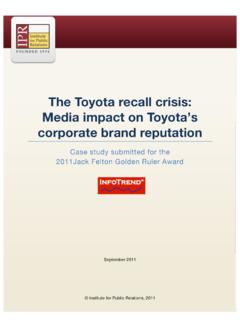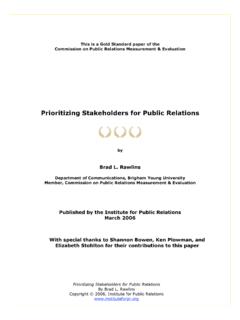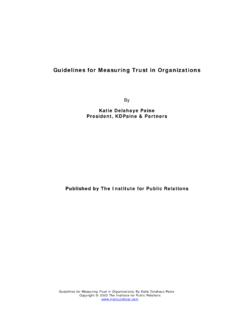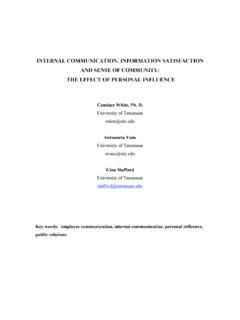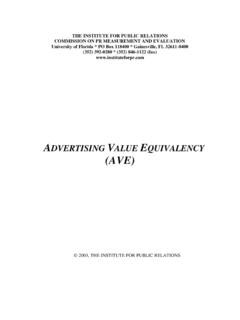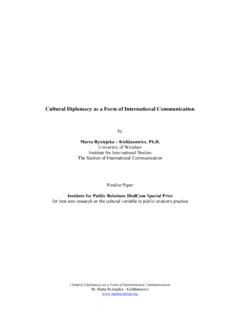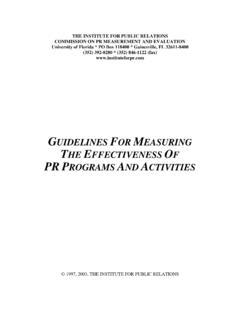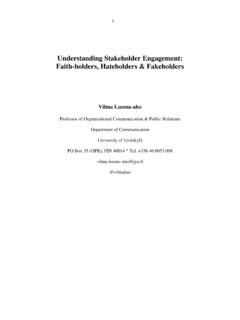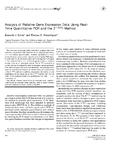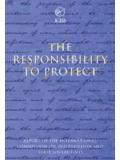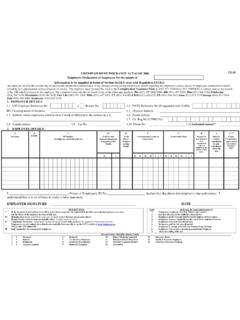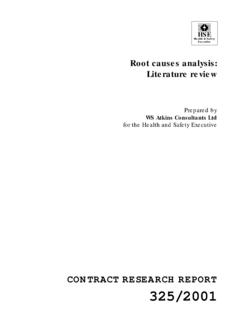Transcription of Speech delivered in Taipei, Taiwan, May 12, 2001
1 The Role of Public Relations in ManagementAnd Its Contribution to Organizational and Societal EffectivenessJames E. GrunigProfessor of Public RelationsDepartment of CommunicationUniversity of MarylandCollege Park, Maryland 20742 USAS peech delivered in Taipei, Taiwan, May 12, 2001 Public relations today is a complex profession practiced by hundreds of thousands of people around theworld. Some public relations professionals are employed by a single organization. Others work for public relationsfirms that have many organizations as clients. Public relations people work for businesses, government agencies,professional and trade associations, nonprofit charities, schools and universities, hospitals, hotels, and many work for large and small organizations.
2 Many public relations people work entirely within their own country;others practice their profession on a global have observed public relations practice around the world as a scholarly researcher for over 35 years. Ingeneral, I believe five trends are occurring. First, public relations is becoming a profession with a scholarly body ofknowledge. Second, public relations is becoming a management function rather than only a technicalcommunication function. Third, public relations practitioners are becoming strategic counselors who are lesspreoccupied with publicity in the mass media than their predecessors. Fourth, public relations has moved from aprofession practiced only by white males to a profession with a female majority and with practitioners of manyracial and ethnic backgrounds.
3 Finally, I believe that almost all public relations practice today is global rather thanconfined to the borders of only one disagree about when public relations was first practiced, who practiced it first, and where it waspracticed originally. Traditionally, Americans have claimed that they invented public relations; but Chinese scholarshave pointed out that Chinese rulers practiced something resembling contemporary public relations over 5,000 yearsago. Even though the first rudimentary practice of public relations may have begun thousands of years ago, publicrelations has been an occupation only for about 100 is only recently, however, that public relations has developed from an occupation to a profession in manycountries of the world. That is, public relations has been something that people did to earn a salary; but it has not2been a discipline for which they studied to prepare for the work.
4 There was no formal education in public was no scholarly research that provided a body of knowledge that could be taught. And there were norecognized standards for effective practice nor ethical principles for the moral practice of public relations. Mostpublic relations practitioners could be described as what the Canadian public relations practitioner Michel Dumascalled "improvised practitioners"--people who practiced public relations without theoretical knowledge of why theypracticed as they did and why public relations is important for an relations also has been an occupation defined more by its techniques than by its theory. Most publicrelations practitioners have been the masters of a number of techniques. They have known how to secure mediacoverage, prepare press releases, write speeches, write and design brochures, produce video news releases, lobbyrepresentatives in Congress, stage a special event, or prepare an annual addition to being an occupation defined by techniques, public relations practitioners also have devotedmost of their efforts to communicating through the mass media.
5 Most have believed that they could affect largenumbers of people through publicity alone. The organizations that employ public relations people also have believedthat they could get massive numbers of people to behave in ways the organizations wanted by creating a good"image" in the , however, the most sophisticated practitioners have begun to understand that people exercise controlover how they use the media to a much greater extent than the media control the behavior of people who use themedia. At the same time, neither public relations practitioners nor the media create the powerful impressions thatusually are called "images." Images are nothing more than what people think, and most people think for construct their own thoughts--their own images--about relations practitioners are most likely to help members of publics construct positive images about theorganization when they counsel the organization to behave in ways that people outside the organization want.
6 Inother words, sophisticated public relations practitioners now understand that they must serve the interests of peopleaffected by organizations if they also are to serve the interests of the organizations that employ , therefore, the organizations that employ individual public relations practitioners or public relationsfirms have begun to recognize public relations as an important management function. They recognize that public3relations has value to an organization because it helps to balance the self interest of the organization with theinterests of people who are affected by the organization or who have the power to affect the organization--peoplethat I call "publics."As public relations has become recognized as a management function, however, its move toward greaterstatus has been affected by the large numbers of women who have entered the profession.
7 In the United States,approximately 75 percent of all public relations students and 60 percent of working professionals are traditionally have been excluded from management roles in the United States, and researchers have foundthat members of the new female majority in public relations have had difficulty being recognized as public relationsmanagers as well as technicians. If public relations is to continue its growth as a management function, therefore,researchers must identify ways to empower women public relations addition to the change in the gender of public relations practitioners in the United States, organizationsalso face increased racial-ethnic diversity in their environments. Publics in the United States now come from manynon-European racial and ethnic groups.
8 Multinational organizations also have publics from around the world. Publicrelations practitioners, therefore, have had to develop principles of multicultural public relations to communicatewith their diverse publics both domestically and relations cannot be practiced as a profession rather than an occupation and a management functionrather a set of techniques unless practitioners have a body of knowledge based on scholarly research available tothem. In the last 25 years, a small group of public relations scholars, first in the United States, and now throughoutthe world, has made remarkable progress in developing a comprehensive theory of public relations that puts publicrelations on a par with recognized professions such as law, medicine, or education.
9 At first public relationsresearchers borrowed heavily from other disciplines such as communication and other social and behavioralsciences. Now, however, they have developed their own body of research and 1985, I have headed a team of six researchers who have conducted research, funded by theInternational Association of Business Communicators Research Foundation, on the characteristics of excellentpublic relations departments and on how such departments make their organizations more effective. We have4studied over 300 organizations in the United States, Canada, and the United Kingdom to identify how organizationspractice public relations in an excellent way--practices that are most likely to make organizations result is a theory that consists of several generic principles that seem to apply throughout the world,although we believe that these concepts must be applied differently in different cultures and political-economicsystems.
10 The theory also applies in different organizational settings such as government agencies, corporations,nonprofit organizations, and associations. In short, the theory offers a conceptual framework for a professionalculture of public relations, which, with appropriate applications and revisions in different organizational andnational cultures, is a fundamental component of effective management throughout the Value of Public RelationsMy colleagues and I began our study of excellent public relations by addressing the research questionposed in a Request for Proposals issued by the IABC Research Foundation: How, why, and to what extent doescommunication contribute to the achievement of organizational objectives? When we began the research, however,the members of the research team realized that the one question posed by the IABC Foundation--the effectivenessquestion--was not enough.
